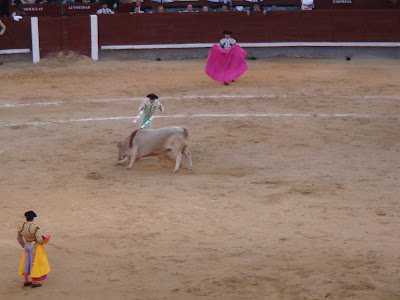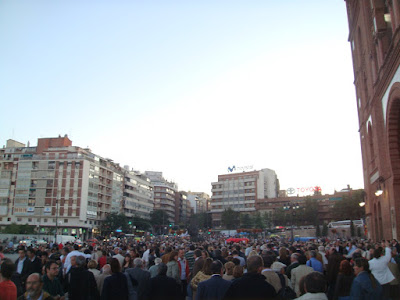
I recently went with 3 friends to Salamanca for a day trip, which is located about two hours northwest of Madrid by train. Because we were a little late getting our act together, we had to settle for a late afternoon train into the city on Saturday and a return trip to Madrid around the same time on Sunday.
We wound up spending almost 3 hours together at a nice white-table cloth restaurant over several courses of food and bottles of wine. That ended around midnight, and we were walking back to our hostel when we met two French students who convinced us to follow them into a nearby club.
This turned out to be an interesting experience because we quickly discovered that Salamanca is mostly a college town with the bars to prove it. Apparently the local university is the oldest one in Spain, having been established in 1218. But now it houses a large percentage of foreign exchange students, all of which seem to like a good party.
Although I talked to several people at the bar that night, not one of them was Spanish. I do, however, remember people from France, Australia, Scotland, and Ireland. The last one was particularly strange because they had spent over a year at UC Santa Barbara, which is about 90 minutes from Cal Poly, my Alma Mater in central California. Small world.
Had I been a bit younger, this bar would have definitely been for me. Unfamiliar with the local custom, I just ordered a beer. While I was waiting for the bartender to bring it, I looked around and noticed everyone else was doing shots. I found that strange but didn't put two-and-two together until later; my beer was €2.50 and hard alcohol shots were €1. These cost structures clearly bring out the best behavior in folks :)
Long story short, I finally threw in the towel and was the "party pooper" by leaving at 3am. I don't mind staying out late, but I had a long list of sites to see before our 3pm train the next day. I'm told the others stayed out until 5am, so perhaps it's not a big surprise I was the only one up early the next day.
My first stop in the morning was one of the highlights, a bridge in the corner of town called the "Puente Romano". It crosses the local river, Rio Tormes, and was originally built during the Roman occupation in the 1st century. Although there are many remnants of the Roman empire scattered around Spain, this was my first experience. I found it very cool to stand under it and contemplate how it was built approximately the same time Jesus lived.
Of course, up close it just looks like a bridge...
 Next on the walking tour was the Casa de las Conchas ("House of Shells"), which as the name suggests has shells on it's outer walls.
Next on the walking tour was the Casa de las Conchas ("House of Shells"), which as the name suggests has shells on it's outer walls. Up close, this is what it looks like. I didn't have time to go inside, but it is now a library.
Up close, this is what it looks like. I didn't have time to go inside, but it is now a library. I had to go out of my way for the next site, but with a name like Casa de las Muertas ("House of the Dead") it's easy to understand why. It looks pretty normal from the street...
I had to go out of my way for the next site, but with a name like Casa de las Muertas ("House of the Dead") it's easy to understand why. It looks pretty normal from the street... But on closer inspection it has very distinctive architecture, like this skull carving. It reminded me of an Indiana Jones movie (the second one which was so terrible).
But on closer inspection it has very distinctive architecture, like this skull carving. It reminded me of an Indiana Jones movie (the second one which was so terrible). There was a square right around the corner with a cool statue and fountain.
There was a square right around the corner with a cool statue and fountain. After Casa de las Muertas, I started to notice all kinds of demonic looking things around Salamanca. I wound up liking most of it, if for no other reason because it was unique. Here's a statue I walked by on a street corner, for instance.
After Casa de las Muertas, I started to notice all kinds of demonic looking things around Salamanca. I wound up liking most of it, if for no other reason because it was unique. Here's a statue I walked by on a street corner, for instance. And later I walked by another statue and stopped to look at the plaque, expecting it to be someone I'd never heard of. Turns out its Christopher Columbus, and at that moment I remembered that he had been commissioned by the Spanish government to explore the "New World". And the rest, as they say, is history.
And later I walked by another statue and stopped to look at the plaque, expecting it to be someone I'd never heard of. Turns out its Christopher Columbus, and at that moment I remembered that he had been commissioned by the Spanish government to explore the "New World". And the rest, as they say, is history. Later on, I walked into a church and was surprised to discover they were in the middle of mass. I stood in the back and tried to look inconspicuous as I quietly snapped pictures. The service was being performed in Latin, which was cool to hear.
Later on, I walked into a church and was surprised to discover they were in the middle of mass. I stood in the back and tried to look inconspicuous as I quietly snapped pictures. The service was being performed in Latin, which was cool to hear. The altar was particularly spectacular. Notice the tiny-looking priest barely visible in the green cloth to get a sense of scale. Certainly a bit more impressive than the ones back home!
The altar was particularly spectacular. Notice the tiny-looking priest barely visible in the green cloth to get a sense of scale. Certainly a bit more impressive than the ones back home! Another site I liked was the Torre del Clavero ("Clavero Tower"), which was built in the late 1400s and is noticeably different than its surroundings. There were all kinds of cheap brick structures in the blocks around it which were covered by spray-paint graffiti. And then there was this tower, ancient and untouched. The contrast was fascinating.
Another site I liked was the Torre del Clavero ("Clavero Tower"), which was built in the late 1400s and is noticeably different than its surroundings. There were all kinds of cheap brick structures in the blocks around it which were covered by spray-paint graffiti. And then there was this tower, ancient and untouched. The contrast was fascinating. This next site wasn't in my guidebook but was fortunately on the local map I'd acquired. It's name is Palacio de la Salina, and I think it used to be a nobleman's house but is now just a historic landmark. Most of it looked the same as everything else in the city, except when I looked towards the ceiling and saw these guys.
This next site wasn't in my guidebook but was fortunately on the local map I'd acquired. It's name is Palacio de la Salina, and I think it used to be a nobleman's house but is now just a historic landmark. Most of it looked the same as everything else in the city, except when I looked towards the ceiling and saw these guys.You'll probably have to click on the pic below and get the full-size version to appreciate the detail in these demonic-looking figures. The lined the entire inside of the main courtyard.
 More of them.
More of them. As with many cities in Spain, its most famous monument is the cathedral. Salamanca is unique because it has two - the "new" one (started in the 16th and completed in the 18th century) was constructed right beside the "old" one (finished in the 13th century). Of course the styles are different, and if I knew more about the subject it probably would have been interesting to have six centuries worth of architectural evolution side-by-side. But alas, I am but a lowly engineer, so most of it went over my head.
As with many cities in Spain, its most famous monument is the cathedral. Salamanca is unique because it has two - the "new" one (started in the 16th and completed in the 18th century) was constructed right beside the "old" one (finished in the 13th century). Of course the styles are different, and if I knew more about the subject it probably would have been interesting to have six centuries worth of architectural evolution side-by-side. But alas, I am but a lowly engineer, so most of it went over my head.This is the newer (and larger) cathedral of the two.
 And it was particularly beautiful when lit at night.
And it was particularly beautiful when lit at night. This was was taken on our way to dinner; anyone feel like a howl?
This was was taken on our way to dinner; anyone feel like a howl? And I've saved the best (in my opinion) for last. Others had claimed Salamanca has one of the best Plaza Majors (main city squares) in the country. This was taken early on a Sunday morning before the traffic really picked up. It's even more impressive in person because all 4 sides of the square look like this.
And I've saved the best (in my opinion) for last. Others had claimed Salamanca has one of the best Plaza Majors (main city squares) in the country. This was taken early on a Sunday morning before the traffic really picked up. It's even more impressive in person because all 4 sides of the square look like this. All this walking around was starting to make me hungry, and I happened to walk by a small bakery right outside the main Plaza. So I popped in and bought these two items; each were 1€ and well worth it. The one on the left reminded me of a sugared sopapilla, and the other resembled a chocolate brownie with a graham-cracker crust.
All this walking around was starting to make me hungry, and I happened to walk by a small bakery right outside the main Plaza. So I popped in and bought these two items; each were 1€ and well worth it. The one on the left reminded me of a sugared sopapilla, and the other resembled a chocolate brownie with a graham-cracker crust. And finally my favorite pic of the trip - the Plaza Mayor at midnight.
And finally my favorite pic of the trip - the Plaza Mayor at midnight.

































